452. Green Wood-Hoopoe (Formerly known as Red-billed Wood-Hoopoe) Phoeniculus purpureus (Rooibekkakelaar)
ORDER BUCEROTIFORMES. Family: Phoeniculidae
Description
33 cm; 80 g. Metallic dark green, with a purple back and very long diamond-shaped purple tail. Distinctive white markings on the wings and white chevrons on the tail edges make it easily identifiable, as does its long thin curved red bill.
Sexes are similar. Female has slightly shorter and straighter bill.
Immatures have a black bill and plumage without iridescence. White spots in primaries and outer tail feathers present. Juvenile Green and Violet Wood-hoopoes probably inseparable in field.
Distribution
Occurs in sub-Saharan Africa, excluding the lowland forest of the DRC and West Africa. Within southern Africa it is common in Mozambique, Zimbabwe, eastern South Africa, northern and eastern Botswana and northern Namibia.
Habitat
It generally prefers arid and mesic savannas, open miombo woodland, riverine forest, forest fringes, valley bushveld, thickets and wooded gardens.
Diet
It mainly eats insects (especially larvae), foraging mainly on tree trunks and branches, probing and searching for food and occasionally descending to the ground.
Breeding
Monogamous, cooperative breeder, meaning that the breeding pair are assisted by non-breeding helpers. Nests in pre-existing cavities such as hollows in trees, fence posts or buildings. But old woodpecker and barbet holes occasionally used. It can lays its eggs at any time of year, although in drier areas such as Namibia laying is usually before or after rain (September-November or March-June). It lays 2-5 blue eggs in successive mornings on the cavity floor. Incubation starts with the penultimate or last egg laid, lasting for 17-18 days. The female is the sole incubator, but she is provided food by the male and group members. The chicks are fed food collected by a number of helpers as well as the male. The female is usually the one who feeds the chicks, but the helpers, especially non-breeding females, will sometimes try to feed the brood, although rarely succeeding. The nestlings stay in the nest for 28-30 days, after which they clumsily fly away, although they still remain in the vicinity of the nest. The parents feed the juveniles for 2-3 months after fledging, sometimes noisily coaxing the juveniles into entering a roost hole. Once the juveniles are settled in, the adults fly away to roost elsewhere. The juveniles are capable of strong flight 3-4 months after leaving the nest, becoming fully independent soon afterward.
Parasitised by Greater and Lesser Honeyguides. Young Honeyguides fed by group up to 3 months after fledging.
Call
Distinctive cackling chorus, performed by all members of group, male’s voice lower pitched than female's. A loud kuk-uk-uk-uk-uk. Listen to Bird Call.
Status
Common resident, sedentary and in groups of 2-14 birds (average 3-4). The Green Wood-Hoopoe is evaluated as Least Concern on the IUCN Red List of Threatened Species.
Africa Wild Bird Book
Africa Wild Bird Book
452. Green Wood-Hoopoe Phoeniculus purpureus
 © steamtrainfan
© steamtrainfan
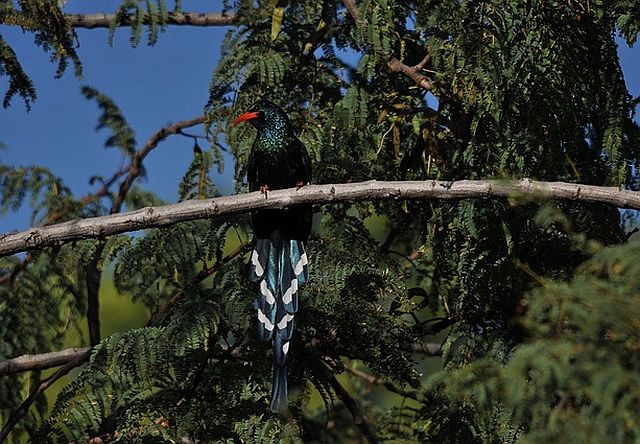 © steamtrainfan
© steamtrainfan
 © leachy
© leachy
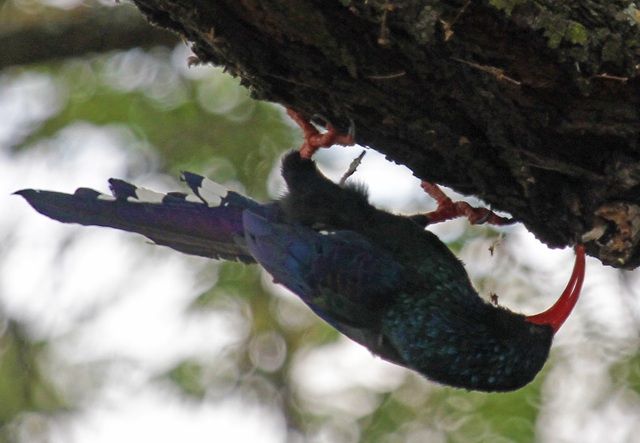 © leachy
© leachy
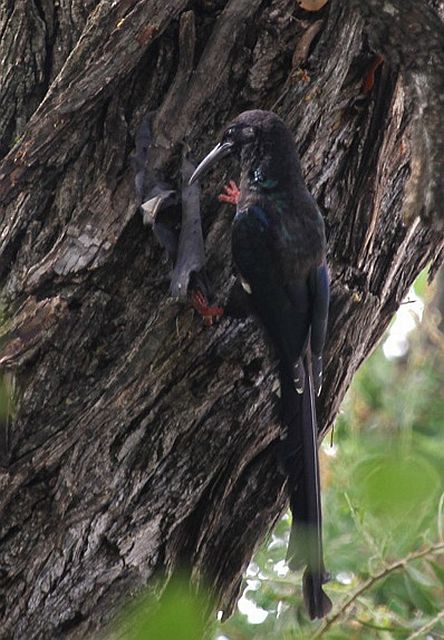 © leachy
© leachy
Juvenile
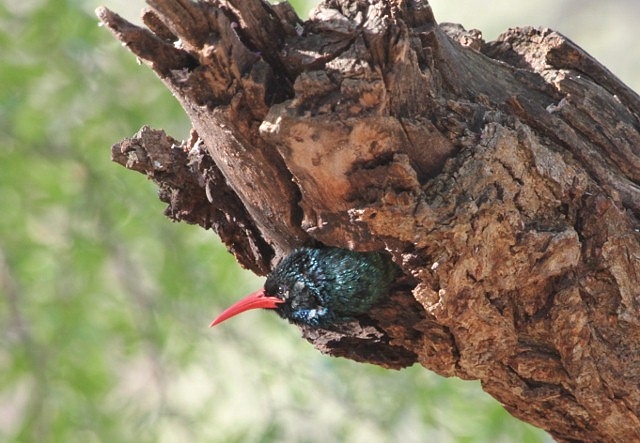 © nan
© nan
 © nan
© nan
Links:
Sabap2: http://sabap2.adu.org.za/spp_summary.ph ... §ion=3
Species text in The Atlas of Southern African Birds: http://sabap2.adu.org.za/docs/sabap1/452.pdf
PFIAO. 2004. What are wood-hoopoes shouting about? Africa - Birds & Birding 9(6):19.
Ian Sinclair,P. A. R. Hockey. The Larger Illustrated Guide to Birds of Southern Africa
NEWMAN'S VOELS VAN SA (8ste UIT): http://books.google.de/books?id=dOTi7T8 ... ll&f=false
Wanless, R. 2001. Preening power: red-billed woodhoopoes go on the defensive. Africa - Birds & Birding 6(1):55-59.
 © steamtrainfan
© steamtrainfan © steamtrainfan
© steamtrainfan © leachy
© leachy © leachy
© leachy © leachy
© leachyJuvenile
 © nan
© nan © nan
© nanLinks:
Sabap2: http://sabap2.adu.org.za/spp_summary.ph ... §ion=3
Species text in The Atlas of Southern African Birds: http://sabap2.adu.org.za/docs/sabap1/452.pdf
PFIAO. 2004. What are wood-hoopoes shouting about? Africa - Birds & Birding 9(6):19.
Ian Sinclair,P. A. R. Hockey. The Larger Illustrated Guide to Birds of Southern Africa
NEWMAN'S VOELS VAN SA (8ste UIT): http://books.google.de/books?id=dOTi7T8 ... ll&f=false
Wanless, R. 2001. Preening power: red-billed woodhoopoes go on the defensive. Africa - Birds & Birding 6(1):55-59.
Violet Wood-hoopoe
453. Violet Wood-Hoopoe Phoeniculus damarensis
Order: Bucerotiformes. Family: Phoeniculidae
The Violet wood-hoopoe's population is small and localized, with an estimated 1 650 birds scattered across Namibian and Angolan Mopane woodland. It is mostly insectivorous, foraging in trees, occasionally dropping to the ground to pick up an insect. It is a monogamous, cooperative breeder, meaning that non-breeding birds help the breeding pair with incubation and caring of the chicks. It nests in tree cavities, laying 4-5 eggs, which are incubated solely by the female. The chicks are cared for by the female, who is supplied with food hunted by the male or group members
Description
34·5–38 cm; 72–96 g. A very dark, large woodhoopoe. Nominate race with dark coppery purple iridescence on crown, face, nape, mantle, back and rump; chin...
Taxonomy
Generally considered to form a species-group with P. purpureus and P. somaliensis (see P. purpureus). Race granti, geographically isolated by huge distance from nominate race, sometimes given full species rank, but this currently considered inappropriate, particularly in light of confusion regarding taxonomic treatment of present species; further research required. Two subspecies recognized.
Distribution and habitat

Its population is small and localized, with an estimated 1 650 birds scattered across Namibia and extending into southern Angola (not included in population figure). It generally prefers Mopane (Colosphermum mopane) woodland, but it may also move into other types of arid woodland.
Food and Feeding
Mostly insects, including beetles, grasshoppers, caterpillars, pupae, beetle larvae; also takes eggs (which are swallowed whole) from nests.
Order: Bucerotiformes. Family: Phoeniculidae
The Violet wood-hoopoe's population is small and localized, with an estimated 1 650 birds scattered across Namibian and Angolan Mopane woodland. It is mostly insectivorous, foraging in trees, occasionally dropping to the ground to pick up an insect. It is a monogamous, cooperative breeder, meaning that non-breeding birds help the breeding pair with incubation and caring of the chicks. It nests in tree cavities, laying 4-5 eggs, which are incubated solely by the female. The chicks are cared for by the female, who is supplied with food hunted by the male or group members
Description
34·5–38 cm; 72–96 g. A very dark, large woodhoopoe. Nominate race with dark coppery purple iridescence on crown, face, nape, mantle, back and rump; chin...
Taxonomy
Generally considered to form a species-group with P. purpureus and P. somaliensis (see P. purpureus). Race granti, geographically isolated by huge distance from nominate race, sometimes given full species rank, but this currently considered inappropriate, particularly in light of confusion regarding taxonomic treatment of present species; further research required. Two subspecies recognized.
Distribution and habitat

Its population is small and localized, with an estimated 1 650 birds scattered across Namibia and extending into southern Angola (not included in population figure). It generally prefers Mopane (Colosphermum mopane) woodland, but it may also move into other types of arid woodland.
Food and Feeding
Mostly insects, including beetles, grasshoppers, caterpillars, pupae, beetle larvae; also takes eggs (which are swallowed whole) from nests.
Violet Wood-hoopoe Photos
453. Violet Wood-Hoopoe Phoeniculus damarensis
© Dindingwe
Halali Camp (Etosha)
© Dindingwe
Halali Camp (Etosha)
Common Scimitarbill
454. Common Scimitarbill (Formerly known as Scimitarbilled Wood-Hoopoe) Rhinopomastus cyanomelas (Swartbekkakelaar)
ORDER BUCEROTIFORMES. Family: Phoeniculidae
Description
The Common Scimitarbill has a height of 28-30 cm and weighs around 35 g. Sexes are similar. Black plumage which in perfect light looks purple glossed. White spotted primaries form a white bar (visible in flight) but without an additional white spot (contra some Wood Hoopoes). Black strongly decurved bill. Black (not red) feet.
Adult male: Plumage mainly dark and iridescent. Crown and face deep blue, mantle and rump violet. Tail long and graduated, with outer rectrices shortest, sometimes with subterminal white spots on outer web. Wing coverts deep blue, sometimes tinged violet. Primaries, secondaries and tertials deep blue. Primaries with white bar or spot on inner web, sometimes also on outer web, forming white wing bar visible in flight but not always at rest. Chin, throat, breast and belly black, feathers tinged blue, some on throat and breast tinged violet. Bill dark horn or black, long and slender, strongly decurved along entire length. Eyes dark brown. Legs and feet black.
Female has brownish ear coverts, throat and breast. The female has a shorter and less robust bill.
Juvenile resembles female but its plumage is duller and the bill slightly less decurved.
Similar species: Black-billed juvs of larger Green and Violet Wood-Hoopoes have similar plumage coloration, with white wing and tail patches, and similarly graduated tails. However, very slender, strongly decurved bill of Common Scimitarbill diagnostic at all ages.
Distribution
It occurs from Kenya and Tanzania through eastern DRC, Angola, Zambia and Malawi to southern Africa. Within southern Africa it is common in Namibia, Botswana, Zimbabwe, Mozambique and northern South Africa.
Habitat
Dry thornveld and open, broad-leaved woodland. It generally prefers tropical and subtropical arid woodland, favouring miombo (Brachystegia) and Mopane (Colosphermum mopane) trees; it avoids closed canopy woodlands.
Diet
Mainly small insects and their larvae, occasionally nectar. It feeds running up and down tree trunks and branches, probing the bark with its bill while using its tail to stabilise itself.
Breeding
Monogamous. It nests in tree cavities, which can be either natural or old woodpecker or barbet holes. They are usually about 30 cm deep, with a 4cm wide entrance. It often competes with Ashy Tits, Crested Barbets, Acacia pied Barbets and Greater Blue-eared Starling for nesting sites. It sometimes uses the same nest site repeatedly over multiple breeding seasons. Egg-laying season is in all months except July-August in Namibia (peak November-March), from August-December in Zimbabwe (peak September-October) and from September-January in South Africa (peak October-November). It lays 2-4 white eggs, which are incubated solely by the female (fed by the male) for about 13-14 days. The chicks fledge at 21-24 days old, usually in the morning. Their first flights are often just 10-50 m long.
Occasionally parasitised by Greater Honeyguide.
Call
A high-pitched, whistling sweep-sweep-sweep, and a plaintive, ventriloquial poui-poui-poui, repeated in phrases of 3-5 syllables; harsh chattering ker-ker-ker used in excitement or alarm. Listen to Bird Call.
Status
Common resident, sedentary and usually in pairs, sometimes in post-br groups of up to 6.
ORDER BUCEROTIFORMES. Family: Phoeniculidae
Description
The Common Scimitarbill has a height of 28-30 cm and weighs around 35 g. Sexes are similar. Black plumage which in perfect light looks purple glossed. White spotted primaries form a white bar (visible in flight) but without an additional white spot (contra some Wood Hoopoes). Black strongly decurved bill. Black (not red) feet.
Adult male: Plumage mainly dark and iridescent. Crown and face deep blue, mantle and rump violet. Tail long and graduated, with outer rectrices shortest, sometimes with subterminal white spots on outer web. Wing coverts deep blue, sometimes tinged violet. Primaries, secondaries and tertials deep blue. Primaries with white bar or spot on inner web, sometimes also on outer web, forming white wing bar visible in flight but not always at rest. Chin, throat, breast and belly black, feathers tinged blue, some on throat and breast tinged violet. Bill dark horn or black, long and slender, strongly decurved along entire length. Eyes dark brown. Legs and feet black.
Female has brownish ear coverts, throat and breast. The female has a shorter and less robust bill.
Juvenile resembles female but its plumage is duller and the bill slightly less decurved.
Similar species: Black-billed juvs of larger Green and Violet Wood-Hoopoes have similar plumage coloration, with white wing and tail patches, and similarly graduated tails. However, very slender, strongly decurved bill of Common Scimitarbill diagnostic at all ages.
Distribution
It occurs from Kenya and Tanzania through eastern DRC, Angola, Zambia and Malawi to southern Africa. Within southern Africa it is common in Namibia, Botswana, Zimbabwe, Mozambique and northern South Africa.
Habitat
Dry thornveld and open, broad-leaved woodland. It generally prefers tropical and subtropical arid woodland, favouring miombo (Brachystegia) and Mopane (Colosphermum mopane) trees; it avoids closed canopy woodlands.
Diet
Mainly small insects and their larvae, occasionally nectar. It feeds running up and down tree trunks and branches, probing the bark with its bill while using its tail to stabilise itself.
Breeding
Monogamous. It nests in tree cavities, which can be either natural or old woodpecker or barbet holes. They are usually about 30 cm deep, with a 4cm wide entrance. It often competes with Ashy Tits, Crested Barbets, Acacia pied Barbets and Greater Blue-eared Starling for nesting sites. It sometimes uses the same nest site repeatedly over multiple breeding seasons. Egg-laying season is in all months except July-August in Namibia (peak November-March), from August-December in Zimbabwe (peak September-October) and from September-January in South Africa (peak October-November). It lays 2-4 white eggs, which are incubated solely by the female (fed by the male) for about 13-14 days. The chicks fledge at 21-24 days old, usually in the morning. Their first flights are often just 10-50 m long.
Occasionally parasitised by Greater Honeyguide.
Call
A high-pitched, whistling sweep-sweep-sweep, and a plaintive, ventriloquial poui-poui-poui, repeated in phrases of 3-5 syllables; harsh chattering ker-ker-ker used in excitement or alarm. Listen to Bird Call.
Status
Common resident, sedentary and usually in pairs, sometimes in post-br groups of up to 6.
Common Scimitarbill Photos
454. Common Scimitarbill Rhinopomastus cyanomelas
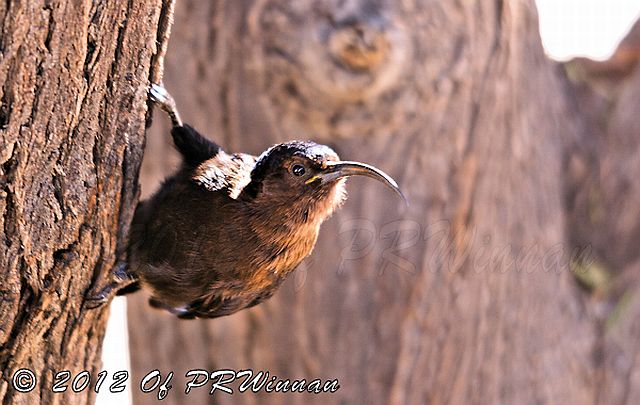 © PRWIN
© PRWIN
 Male © ExFmem
Male © ExFmem
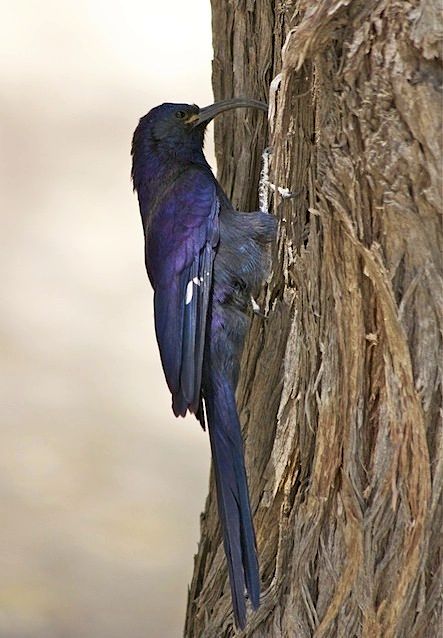 © ExFmem
© ExFmem
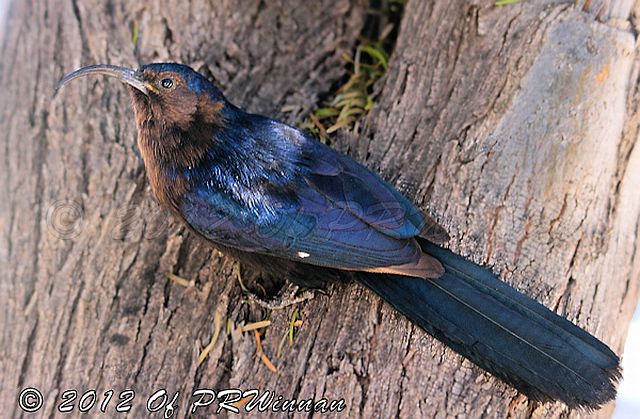 Female © PRWIN
Female © PRWIN
 © Dewi
© Dewi
Links:
Species text in The Atlas of Southern African Birds
Sabap2: http://sabap2.adu.org.za/spp_summary.ph ... §ion=3
Ian Sinclair,P. A. R. Hockey. The Larger Illustrated Guide to Birds of Southern Africa
NEWMAN'S VOELS VAN SA (8ste UIT)
 © PRWIN
© PRWIN Male © ExFmem
Male © ExFmem © ExFmem
© ExFmem Female © PRWIN
Female © PRWIN © Dewi
© Dewi Links:
Species text in The Atlas of Southern African Birds
Sabap2: http://sabap2.adu.org.za/spp_summary.ph ... §ion=3
Ian Sinclair,P. A. R. Hockey. The Larger Illustrated Guide to Birds of Southern Africa
NEWMAN'S VOELS VAN SA (8ste UIT)
Family Bucerotidae (Hornbills)
Hornbills (Bucerotidae) are a family of bird found in tropical and subtropical Africa and Asia. There are 51 species spread over 8 genera. They are characterized by a long, down-curved bill which is frequently brightly colored and sometimes has a casque on the upper mandible. Both the common English and the scientific name of the family refer to the shape of the bill, "buceros" being "cow horn" in Greek. In addition, they possess a two-lobed kidney. Hornbills are the only birds in which the first two neck vertebrae (the axis and atlas) are fused together; this probably provides a more stable platform for carrying the bill. The family is omnivorous, feeding on fruit and small animals. They are monogamous breeders nesting in natural cavities in trees and sometimes cliffs.
Bucerotidae (Hornbills) have developped a unique nesting behaviour. The female enters the nest cavity before laying starts; the male brings mud and debris, which the female takes and plasters around the entrance until only a slit is left. The male passes food to the female through the slit until after the young are more or less grown. At that time she breaks out of the nest, and then both parents feed the young.
♥ Tokos ♥ are the species of the genera Tockus and Ocyceros. The genus Tockus contains 15 species and is found only in Africa. They are the smallest members of the Hornbills (Bucerotidae). The genus Ocyceros occurs in South Asia.
Tokos are bushland residents. Tokos show a lifelong pair bond. The nests are created in a larger tree cavity and bricked with saliva, mud and fruit puree to a small opening.
Bycanistes is a genus of medium to large, primarily frugivorous hornbills found in the forests and woodlands of sub-Saharan Africa. They have often been included in the genus Ceratogymna, but today most authorities consider them separate. All species in this genus have a black and white plumage. The plumage of the sexes is similar, but the casque of the male is larger than that of the female.
Links:
Africa Wild: Hornbill - Bird of the Month: November 2012
Bucerotidae (Hornbills) have developped a unique nesting behaviour. The female enters the nest cavity before laying starts; the male brings mud and debris, which the female takes and plasters around the entrance until only a slit is left. The male passes food to the female through the slit until after the young are more or less grown. At that time she breaks out of the nest, and then both parents feed the young.
♥ Tokos ♥ are the species of the genera Tockus and Ocyceros. The genus Tockus contains 15 species and is found only in Africa. They are the smallest members of the Hornbills (Bucerotidae). The genus Ocyceros occurs in South Asia.
Tokos are bushland residents. Tokos show a lifelong pair bond. The nests are created in a larger tree cavity and bricked with saliva, mud and fruit puree to a small opening.
Bycanistes is a genus of medium to large, primarily frugivorous hornbills found in the forests and woodlands of sub-Saharan Africa. They have often been included in the genus Ceratogymna, but today most authorities consider them separate. All species in this genus have a black and white plumage. The plumage of the sexes is similar, but the casque of the male is larger than that of the female.
Links:
Africa Wild: Hornbill - Bird of the Month: November 2012
Family Bucerotidae (Hornbills) Index
All five African Red-billed Tokos were formerly considered conspecific. They are now usually split into five species, the Northern Red-billed Hornbill (T. erythrorhynchus), Western Red-billed Hornbill (T. kempi), Tanzanian Red-billed Hornbill (T. ruahae), Southern Red-billed Hornbill (T. rufirostris) and Damara Red-billed Hornbill (T. damarensis).
Kemp, A.C. and W. Delport. 2002. Comments on the status of subspecies in the red-billed hornbill (Tockus erythrorhynchus) complex (Aves: Bucerotidae), with the description of a new taxon endemic to Tanzania. Annals of the Transvaal Museum 39: 1–8.
Family Bucerotidae (Hornbills)
Lophoceros alboterminatus Crowned Hornbill 460
Lophoceros bradfieldi Bradfield's Hornbill 461
Lophoceros nasutus African Grey Hornbill 457
Tockus monteiri Monteiro's Hornbill 462
Tockus damarensis Damara Red-billed Hornbil
Tockus rufirostris Southern Red-billed Hornbill 458 (Split from T. erythrorhynchus - Kemp & Delport 2002)
Tockus leucomelas Southern Yellow-billed Hornbill 459
Bycanistes bucinator Trumpeter Hornbill 455
Bycanistes brevis Silvery-cheeked Hornbill 456
Kemp, A.C. and W. Delport. 2002. Comments on the status of subspecies in the red-billed hornbill (Tockus erythrorhynchus) complex (Aves: Bucerotidae), with the description of a new taxon endemic to Tanzania. Annals of the Transvaal Museum 39: 1–8.
Family Bucerotidae (Hornbills)
Lophoceros alboterminatus Crowned Hornbill 460
Lophoceros bradfieldi Bradfield's Hornbill 461
Lophoceros nasutus African Grey Hornbill 457
Tockus monteiri Monteiro's Hornbill 462
Tockus damarensis Damara Red-billed Hornbil
Tockus rufirostris Southern Red-billed Hornbill 458 (Split from T. erythrorhynchus - Kemp & Delport 2002)
Tockus leucomelas Southern Yellow-billed Hornbill 459
Bycanistes bucinator Trumpeter Hornbill 455
Bycanistes brevis Silvery-cheeked Hornbill 456
Crowned Hornbill
460. Crowned Hornbill Lophoceros alboterminatus (Gekroonde Neushoringvoël)
Order: Bucerotiformes. Family: Bucerotidae
Description
The Crowned Hornbill is a medium-sized slender dark hornbill, 50-54 cm long. Bill casqued (no other red-billed hornbills have casque); vertical creamy yellow line at base of bill diagnostic. Upperparts and head are uniform dark brown. White tips to outer tail feathers. It has a white belly. The eyes are yellow; skin around eye dark brown to black; bill red to red-brown, basal band creamy yellow; gular skin (♂) black, (♀) yellow, greenish to blue-green; legs and feet blackish, soles whitish. In females, the casque is smaller.
Juvenile: Lacks casque, bill yellow; no white on outer rectrices; eye grey.
Similar species: The Crowned Hornbill can be distinguished from the similar Bradfield's Hornbill by its shorter beak.
Distribution
It occurs from the DRC and Ethiopia to southern Africa (locally common in Zimbabwe, Mozambique, KwaZulu-Natal, Eastern Cape and marginally in the Western Cape).

Habitat
A common resident of the montane, coastal and riverine forests and woodland.
Diet
It eats a wide range of small animals, doing most of its foraging among foliage and looking for invertebrates and fruit.
Breeding
It nests in tree cavities up to about 12 m above ground, often using the same site repeatedly over many breeding seasons. It also visits the site throughout the year, with the frequency of visits increasing as the breeding season draws near. About 1-2 weeks before the beginning of the egg-laying period, the female seals herself in the nest using her own faeces. She leaves a small vertical slit, which the male uses to give food to her. The egg-laying season begins with the onset of the summer rains, from October-January, peaking from October-January. The female lays 2-5, usually 3-4 white eggs, which are incubated solely by the female for about 25-27 days, being fed by the male through a narrow slit. The female leaves the nest when the oldest chick is 25-30 days old, after which the brood reseal the entrance. The chicks stay in the nest for 46-55 days and are able to feed for themselves one month after fledging, becoming fully independent roughly 5-7 months later.
Call
Loud high-pitched whistling notes. Listen to Bird Call.
Status
Fairly common resident.
Order: Bucerotiformes. Family: Bucerotidae
Description
The Crowned Hornbill is a medium-sized slender dark hornbill, 50-54 cm long. Bill casqued (no other red-billed hornbills have casque); vertical creamy yellow line at base of bill diagnostic. Upperparts and head are uniform dark brown. White tips to outer tail feathers. It has a white belly. The eyes are yellow; skin around eye dark brown to black; bill red to red-brown, basal band creamy yellow; gular skin (♂) black, (♀) yellow, greenish to blue-green; legs and feet blackish, soles whitish. In females, the casque is smaller.
Juvenile: Lacks casque, bill yellow; no white on outer rectrices; eye grey.
Similar species: The Crowned Hornbill can be distinguished from the similar Bradfield's Hornbill by its shorter beak.
Distribution
It occurs from the DRC and Ethiopia to southern Africa (locally common in Zimbabwe, Mozambique, KwaZulu-Natal, Eastern Cape and marginally in the Western Cape).

Habitat
A common resident of the montane, coastal and riverine forests and woodland.
Diet
It eats a wide range of small animals, doing most of its foraging among foliage and looking for invertebrates and fruit.
Breeding
It nests in tree cavities up to about 12 m above ground, often using the same site repeatedly over many breeding seasons. It also visits the site throughout the year, with the frequency of visits increasing as the breeding season draws near. About 1-2 weeks before the beginning of the egg-laying period, the female seals herself in the nest using her own faeces. She leaves a small vertical slit, which the male uses to give food to her. The egg-laying season begins with the onset of the summer rains, from October-January, peaking from October-January. The female lays 2-5, usually 3-4 white eggs, which are incubated solely by the female for about 25-27 days, being fed by the male through a narrow slit. The female leaves the nest when the oldest chick is 25-30 days old, after which the brood reseal the entrance. The chicks stay in the nest for 46-55 days and are able to feed for themselves one month after fledging, becoming fully independent roughly 5-7 months later.
Call
Loud high-pitched whistling notes. Listen to Bird Call.
Status
Fairly common resident.
Crowned Hornbill Photos
460. Crowned Hornbill Lophoceros alboterminatus
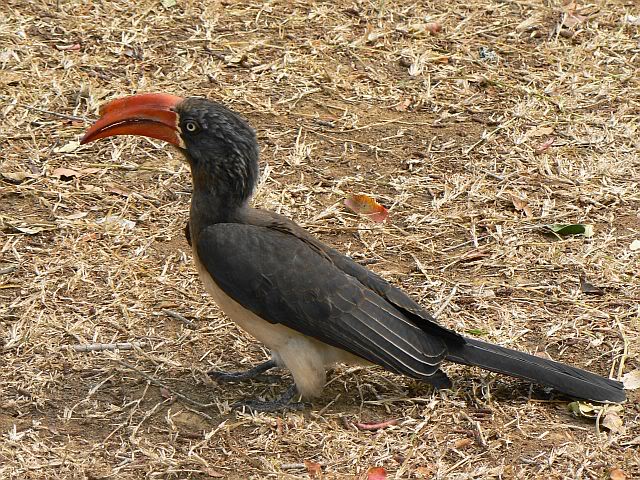
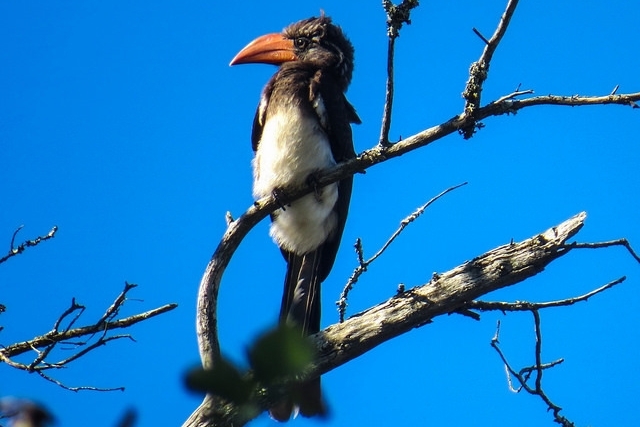 © steamtrainfan
© steamtrainfan
Juvenile, Bathurst
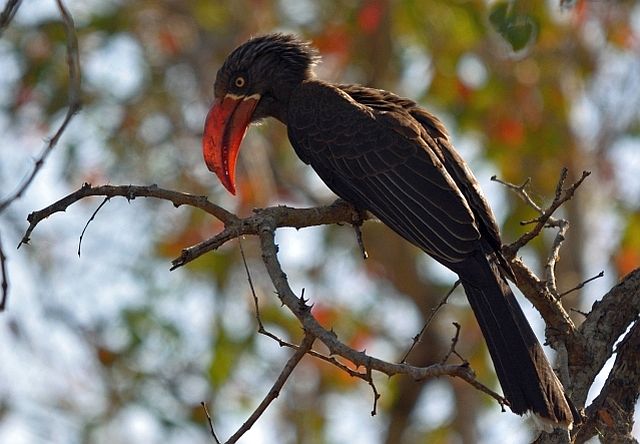 © BluTuna
© BluTuna
 © Dewi
© Dewi
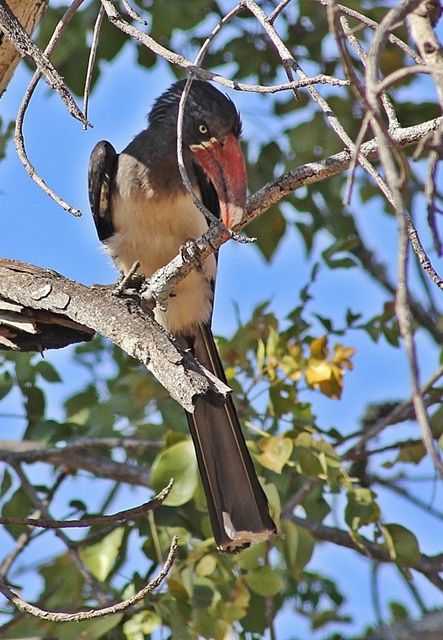 © Amoli
© Amoli
Links:
Sabap2
Oiseaux net
NEWMAN'S VOELS VAN SA (8ste UIT)

 © steamtrainfan
© steamtrainfanJuvenile, Bathurst
 © BluTuna
© BluTuna © Dewi
© Dewi © Amoli
© AmoliLinks:
Sabap2
Oiseaux net
NEWMAN'S VOELS VAN SA (8ste UIT)


